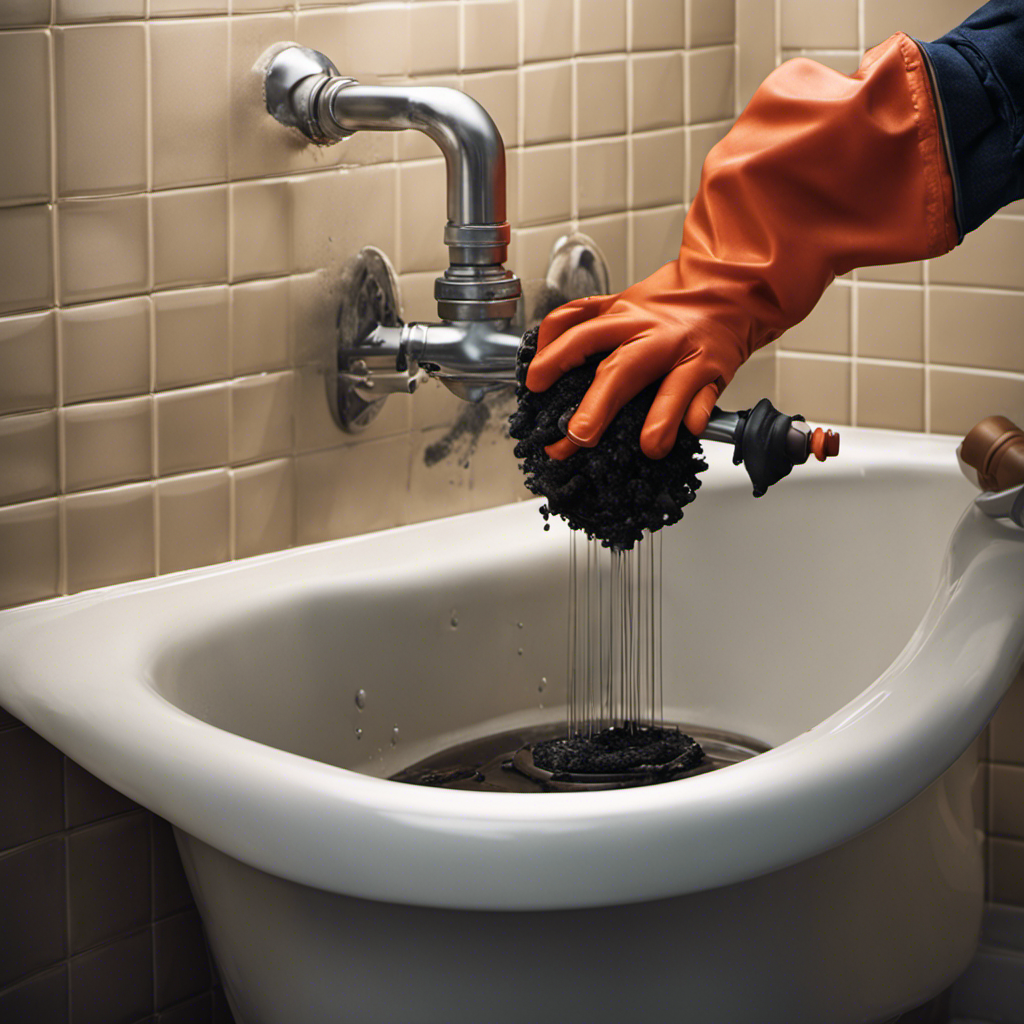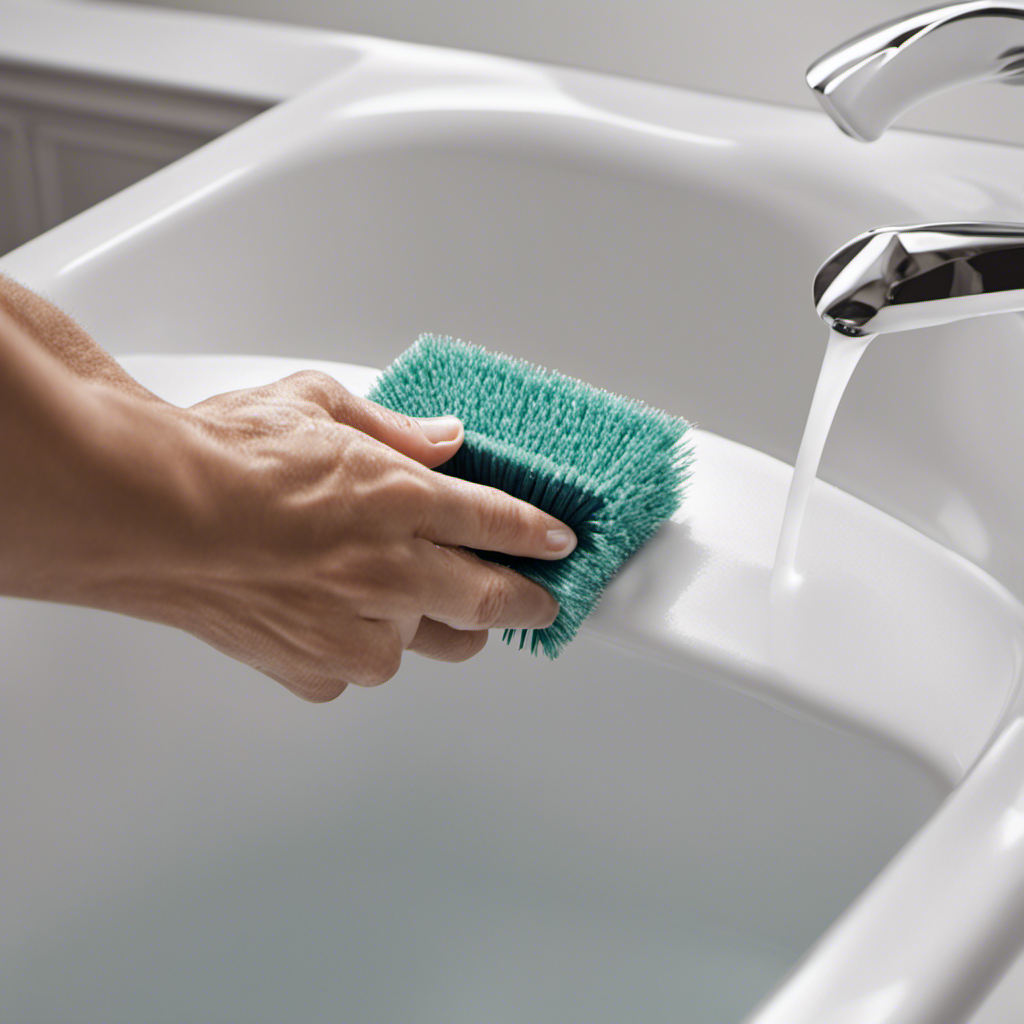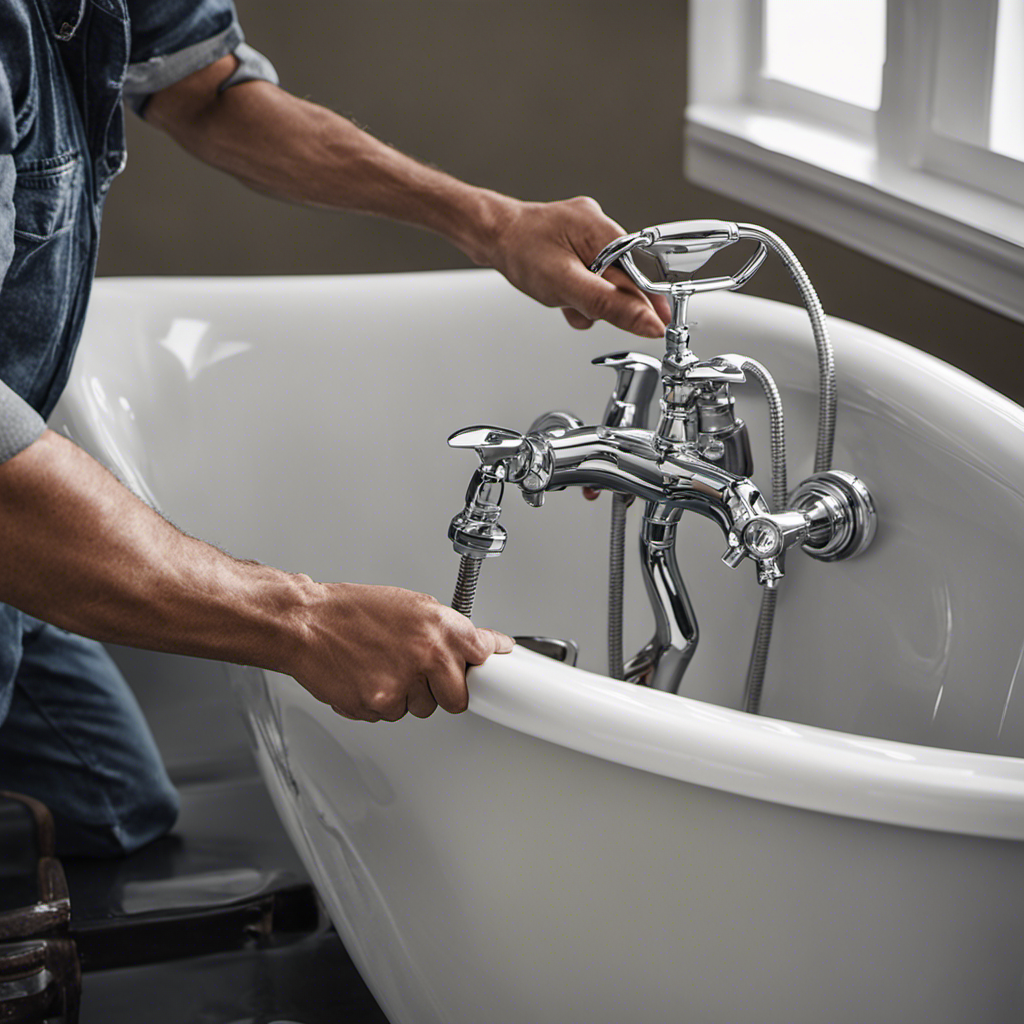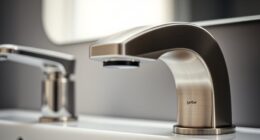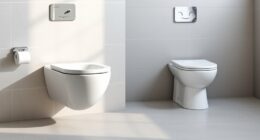I’ve been there before, standing ankle-deep in water, frustrated with a clogged bathtub drain. Luckily, I’ve learned a few tricks that can help you tackle this common household problem.
In this article, I’ll show you how to clean a clogged bathtub drain using simple tools and homemade solutions. From removing the drain cover to using a plunger or drain snake, I’ll guide you through the steps to get your drain flowing smoothly again.
Say goodbye to standing water and hello to a clean, clog-free bathtub!
Key Takeaways
- Hair falling into the drain and soap scum are common causes of clogged bathtub drains.
- Regular cleaning using baking soda, vinegar, and boiling water can help dissolve hair and soap scum.
- Essential cleaning tools like a plunger, drain snake, and baking soda and vinegar are effective in unclogging drains.
- Preventative measures such as installing a drain strainer and avoiding pouring substances like grease, oil, and coffee grounds down the drain can help prevent future clogs.
Understanding the Causes of a Clogged Bathtub Drain
Understanding the causes of a clogged bathtub drain can help you prevent future blockages. One of the most common causes is hair. When we wash our hair in the shower, loose strands can easily fall into the drain and accumulate over time. These hair clogs can quickly become a nuisance and cause water to drain slowly or not at all.
Another cause of clogged bathtub drains is the buildup of soap scum and residue. These substances can stick to the inside of the pipes and create blockages.
Fortunately, there are some common household items that can help with drain cleaning. Baking soda, vinegar, and boiling water can effectively break down hair and soap scum, allowing for better drainage.
Now that we understand the causes of clogged drains and have some basic knowledge of drain cleaning, let’s move on to gathering the necessary tools and supplies.
Gathering the Necessary Tools and Supplies
When it comes to tackling a clogged bathtub drain, having the essential cleaning tools is crucial. With the right tools, you can effectively unclog the drain and prevent further issues.
In this discussion, we will explore the necessary tools and techniques for properly unclogging a drain, ensuring a smooth and hassle-free process.
Essential Cleaning Tools
To clean your clogged bathtub drain, you’ll need some essential cleaning tools. These tools will help you effectively remove any debris or buildup that might be causing the clog. Here are the necessary tools:
| Tools | Description |
|---|---|
| Plunger | Used to create pressure and dislodge clogs |
| Drain snake | Helps remove clogs deeper in the drain |
| Baking soda and vinegar | Natural cleaning agents that can dissolve clogs |
Using these tools, you can try various bathtub drain cleaning methods. If you’re unsure or uncomfortable with performing the task yourself, it’s best to seek professional drain cleaning services. These experts have the knowledge and equipment to handle even the most stubborn clogs. Remember, proper maintenance and regular cleaning can help prevent future clogs and keep your bathtub drain running smoothly.
Proper Drain Unclogging
Using a plunger or drain snake can effectively remove clogs in your bathtub. However, it is important to remember that proper drain maintenance is crucial to prevent future clogs and maintain optimal drainage.
Regularly cleaning your bathtub drain can help prevent buildup of hair, soap scum, and other debris that can lead to clogs. One way to ensure proper drain maintenance is by using professional drain cleaning services.
These services utilize specialized tools and techniques to thoroughly clean and unclog your drain, ensuring that it functions properly and efficiently. Professional drain cleaning services can also identify any underlying issues, such as tree root intrusion or pipe damage, and provide appropriate solutions.
Removing and Cleaning the Bathtub Drain Cover
First, you’ll need to remove the bathtub drain cover before you can clean it. To do this, follow these steps:
- Locate the screws or tabs securing the drain cover in place.
- Use a screwdriver or your fingers to loosen and remove the screws or tabs.
- Lift the drain cover off the drain opening.
Once the drain cover is removed, you can begin cleaning it. One of the most effective cleaning methods is to use a mixture of warm water and dish soap. Scrub the drain cover using a soft brush or sponge to remove any dirt, grime, or soap scum. For stubborn debris, you can also use a toothbrush or a toothpick to gently dislodge it.
Additionally, removing hair from the drain cover is crucial for maintaining proper drainage. You can use tweezers or a hair removal tool to carefully pull out any hair trapped in the cover’s holes.
Remember to rinse the drain cover thoroughly before reattaching it to the drain opening.
Using a Plunger to Clear the Clog
After removing the drain cover, you can try using a plunger to clear the clog. Plungers are a common tool used for unclogging drains and can be quite effective.
To use a plunger, you’ll want to make sure you have a good seal over the drain opening. Place the plunger over the drain, ensuring that it covers the entire opening. Then, using a firm and steady motion, push and pull the plunger vigorously to create suction and dislodge the clog.
If the plunger doesn’t work, there are alternatives you can try before resorting to chemicals. One option is using a drain snake, which is a long, flexible tool that can be inserted into the drain to break up the clog.
Another alternative is using a mixture of baking soda and vinegar, which can help dissolve and remove the clog naturally.
Using a Homemade Drain Cleaner Solution
Vinegar and baking soda are two key ingredients in an effective and eco-friendly homemade drain cleaner solution. When combined, they create a powerful reaction that helps break up clogs and remove debris from your pipes.
Not only is this method safe for the environment, but it is also cost-effective and easy to use.
Vinegar and Baking Soda
Using vinegar and baking soda is a quick and effective way to unclog a bathtub drain. These common household ingredients provide a natural and chemical-free solution. However, there are alternatives to vinegar and baking soda that can also be used for this purpose.
Here are the pros and cons of vinegar and baking soda:
-
Vinegar:
-
Pros: It is readily available, affordable, and has natural disinfectant properties.
-
Cons: It may not be strong enough to tackle severe clogs and may leave behind a strong odor.
-
Baking Soda:
-
Pros: It is a gentle abrasive that can break down grease and grime.
-
Cons: It may not be as effective on tough clogs and may require multiple applications.
Transition: While vinegar and baking soda are popular choices, there are other effective and eco-friendly methods to consider.
Effective and Eco-Friendly
There are several alternative methods that are both effective and eco-friendly for unclogging a bathtub drain.
When it comes to maintaining a clean and functional drain, using eco-friendly cleaning products and natural drain cleaning methods is a smart choice.
One option is to use a mixture of baking soda and vinegar. Start by pouring half a cup of baking soda down the drain, followed by half a cup of vinegar. Let the mixture sit for about 30 minutes, then flush it with hot water. The chemical reaction between the baking soda and vinegar helps to break down clogs and clear the drain.
Another method is to use a combination of salt and hot water. Dissolve half a cup of salt in a pot of hot water and pour it down the drain. Let it sit for a few minutes, then flush with more hot water. The salt helps to dissolve grease and other debris, effectively clearing the clog.
These eco-friendly methods are not only effective in unclogging a bathtub drain, but they are also safe for the environment.
Using a Drain Snake to Clear Stubborn Clogs
To effectively clear stubborn clogs in your bathtub drain, you’ll need to use a drain snake. This handy tool is designed to navigate through the pipes and break up the blockage, allowing the water to flow freely again.
Drain snake maintenance is important to ensure its effectiveness and longevity. Here are a few tips to keep your drain snake in top condition:
- Regularly clean the snake after each use to remove debris and buildup.
- Inspect the cable for any signs of damage or wear and replace if necessary.
- Store the drain snake in a dry place to prevent rust and corrosion.
While a drain snake is highly effective, there are alternative drain cleaning methods you can try. These include using a plunger, pouring boiling water down the drain, or utilizing a mixture of baking soda and vinegar. However, for stubborn clogs, a drain snake remains the most reliable and efficient option.
Preventative Measures to Avoid Future Clogs
Make sure you regularly inspect and maintain your pipes to prevent future clogs in your bathtub. Taking preventative measures is essential for avoiding the hassle of dealing with clogged drains in the long run.
One of the most effective long term solutions is to install a drain strainer in your bathtub. This simple device catches hair and other debris, preventing them from entering the drain and causing blockages.
Additionally, using a biodegradable drain cleaner once a month can help break down any buildup and keep your pipes clear. It is also important to avoid pouring grease, oil, or coffee grounds down the drain, as they can solidify and cause clogs.
Conclusion
In conclusion, keeping your bathtub drain clean and unclogged is essential for a smooth and relaxing bathing experience. By understanding the causes of clogs and utilizing the right tools and techniques, you can easily maintain a clear drain.
Remember, prevention is key, so taking proactive measures like using drain covers and regular cleaning can save you from future headaches. As the saying goes, "An ounce of prevention is worth a pound of cure."
So, take charge of your drain maintenance and enjoy a hassle-free bathing experience!
